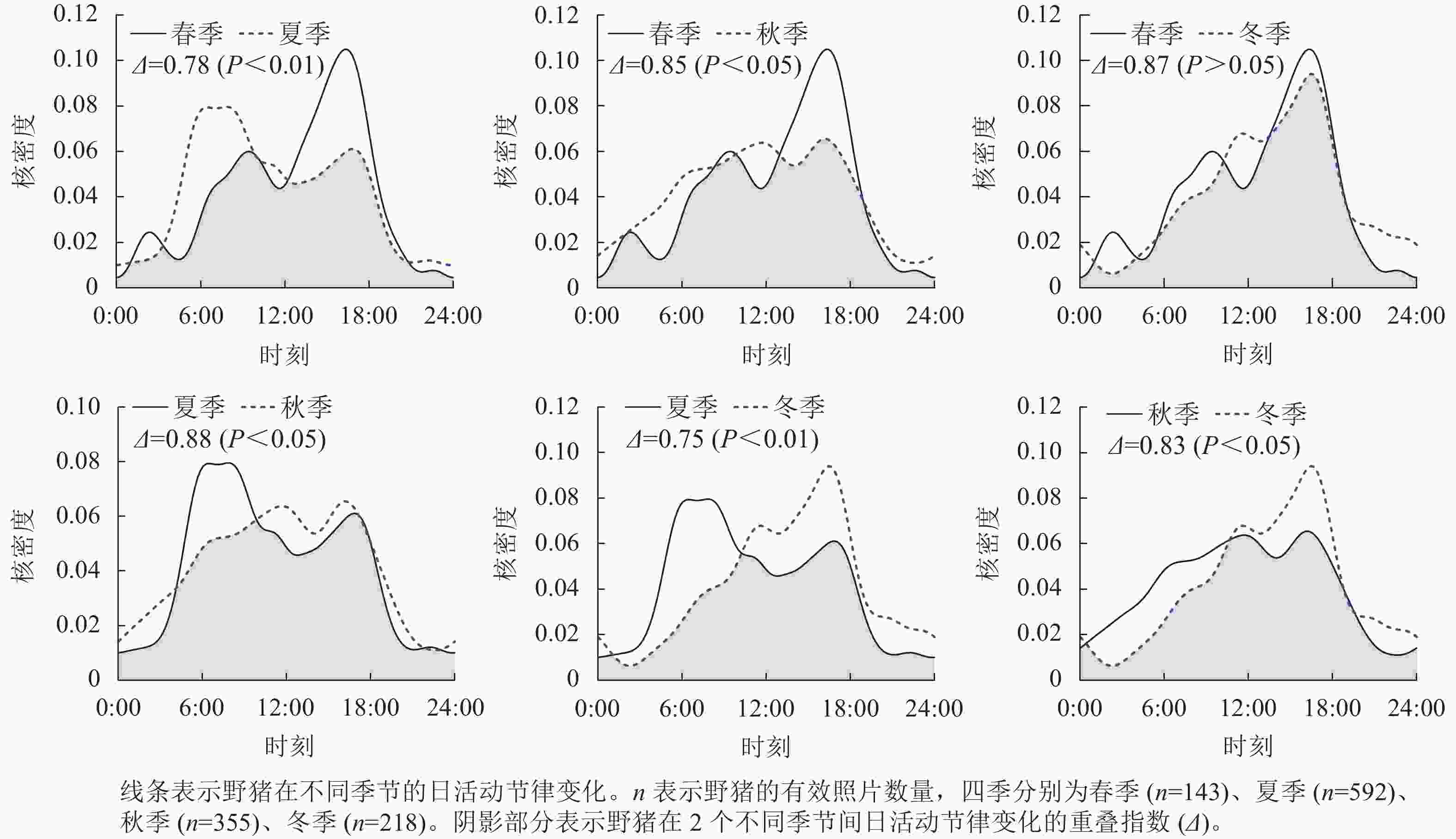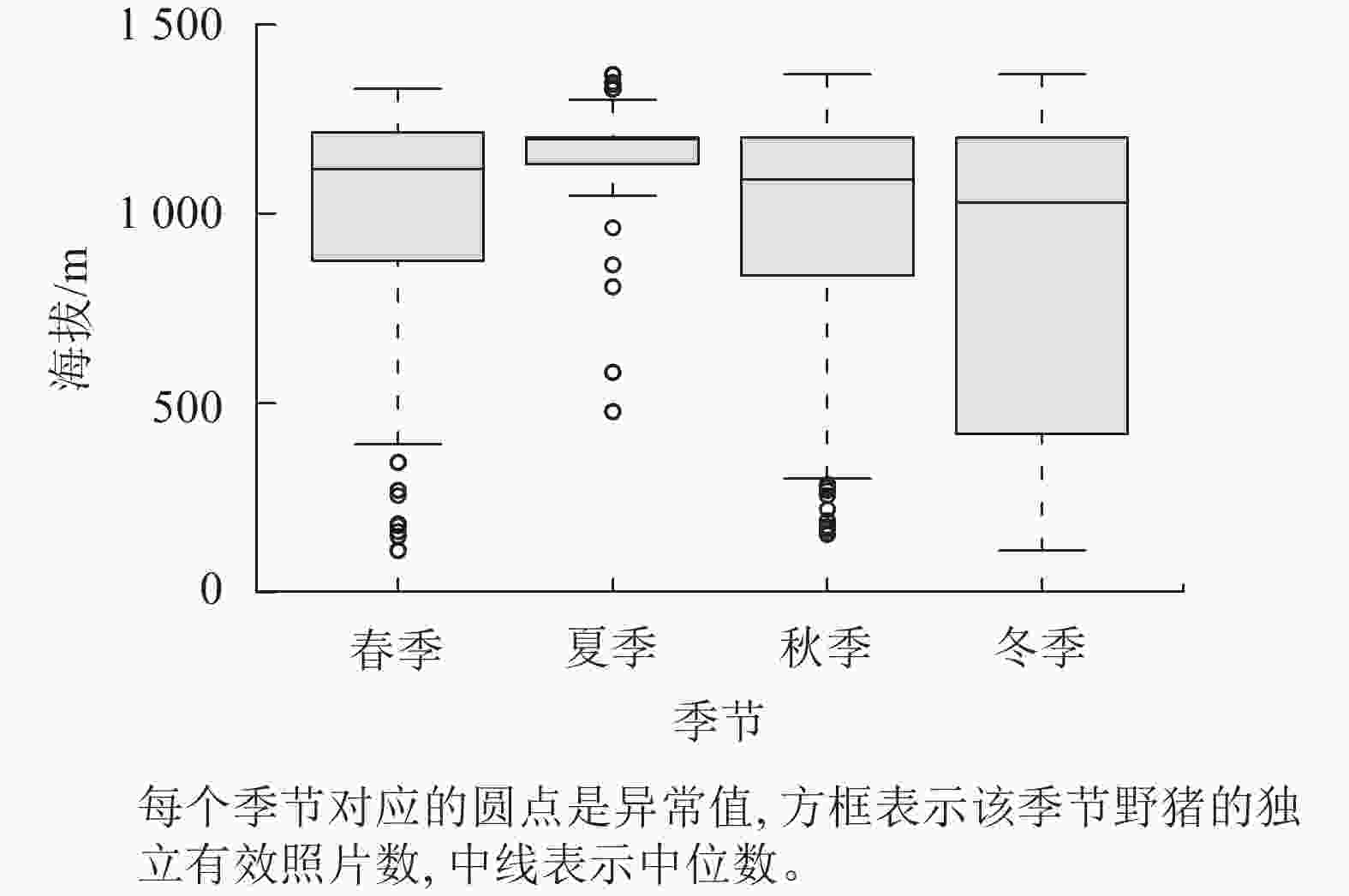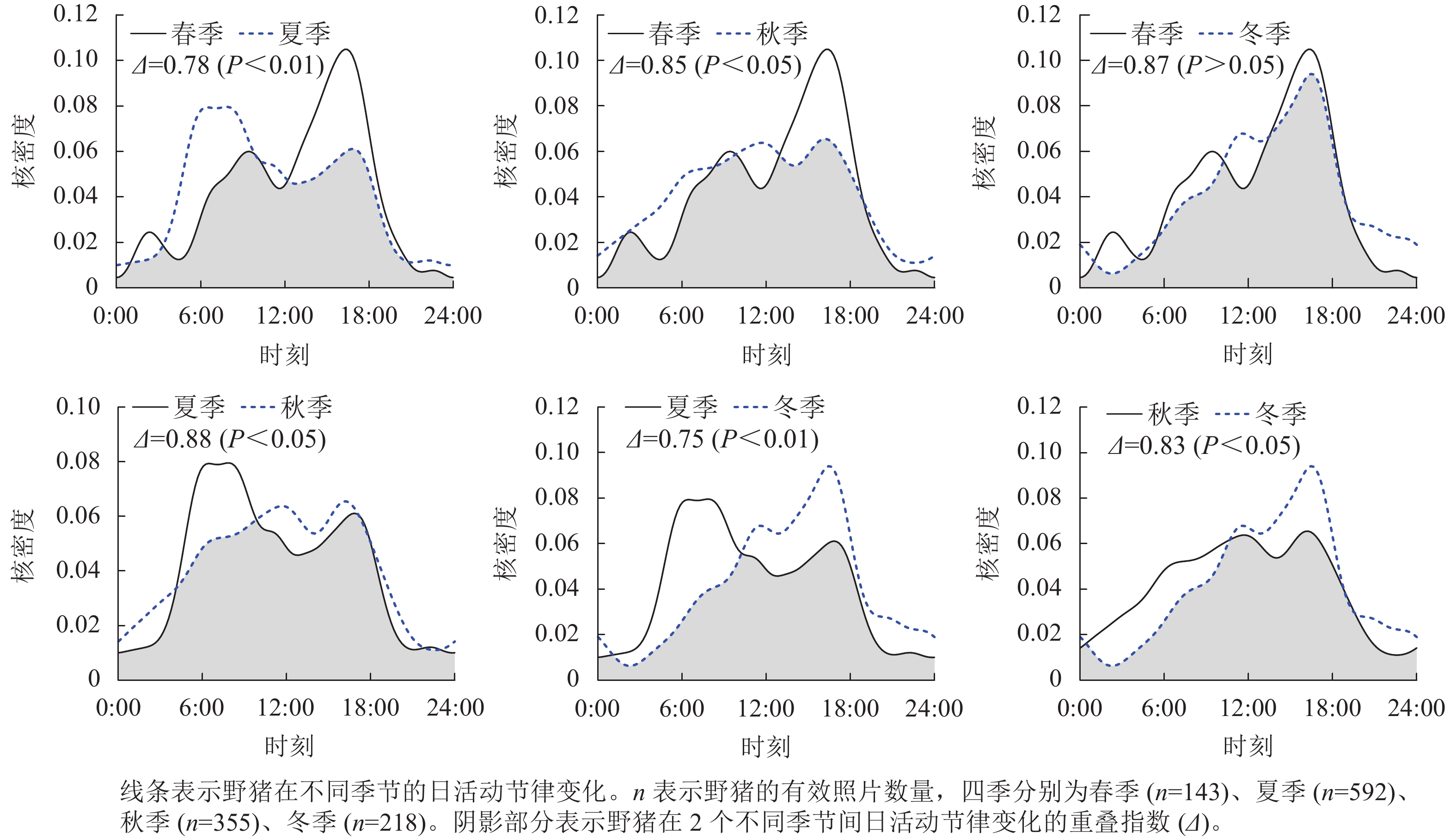-
野猪Sus scrofa隶属哺乳纲Mammalia偶蹄目Artiodactyla,原产于欧亚大陆,是目前世界上分布最广泛的哺乳动物之一[1]。在中国,野猪主要分布于大兴安岭、松辽平原、长白山区、黄淮平原、黄土高原以及西南山区和华南丘陵等地带。由于较强的适应和繁殖能力[2],野猪即使在受人类活动高度影响的地区也能生存和良好成长[3−4]。随着天然林保护工程和退耕还林等生态保护修复工程的实施,野猪的天敌如虎Panthera tigris、豹Panthera pardus、狼Canis lupus等野生动物的种群数量减少,这为野猪繁衍提供了理想的条件,以至于近20 a来中国野猪种群在较短时间内得到了有效恢复。然而随着种群的不断增长,野猪已对局部区域居民的生产生活造成了严重的负面影响[5−6]。如张学娟等[7]研究发现:2000—2021年野猪致害导致的农作物损失面积显著高于2000年以前。袁小清等[8]在黑龙江省桦南县运用结构方程模型对当地居民进行抽样调查研究,发现当地受访者总体上对野猪持消极态度。
目前,野猪已不存在生存威胁,很多区域种群数量过高,已经符合调整基本原则。在此背景下,2023年国家林业和草原局宣布将野猪移出了国家“三有保护名录”。但这并不意味着可以随意捕猎野猪,如何开展捕猎需要建立在对区域野猪种群结构及危害特征准确调研的基础上[1, 9−10]。野猪种群规模的控制已成为目前野生动物保护和生态可持续发展中面临的一个非常重要而现实的问题。而且有研究表明:人与野猪之间的冲突具有明显的区域性特征[11]。因此,野猪种群分布的调查、计算方法和案例应用都需要进一步探索,特别是针对县域管控单元的野猪种群数量、活动规律和防控策略都缺乏案例研究。
根据浙江省龙游县林业部门的监测和记录,野猪已对当地农林生产和周边村民的生产生活构成了潜在的威胁。然而,目前龙游县野猪的种群结构及数量特征尚不明确,难以对其种群发展动态和潜在威胁做出科学的评估,也严重制约了野猪防控策略的制定。鉴于此,本研究对浙江省龙游县野猪种群现状进行调查和监测,基于红外相机捕获率构建野猪种群的随机相遇模型,估算其种群密度,揭示野猪种群的活动节律与生境之间的关系,以期为区域野猪防控措施的制定提供科学依据。
-
龙游县位于浙江省衢州市(28°44′~29°17′N,119°02′~119°20′E),地处金衢盆地中部,海拔为33~1 442 m,县域总面积为1 143 km2。境内山脉、丘陵、平原、河流兼具。地形南北高,中部低,呈马鞍形分布,其中中部地区主要为盆地平原区域,是城镇集中分布区。该区属亚热带季风型气候,地域温度适中、光照充足、雨量充沛、旱涝明显。年均气温为17.1 ℃,年均降水量达1 602.6 mm。在森林植被分区上属中亚热带东部常绿阔叶林亚带,由于南北光热条件不同,又分为2个植被区。北部的浙皖山丘青冈Quercus glauca、苦槠Castanopsis sclerophylla植被区与南部的浙闽山丘甜槠Castanopsis eyrei、木荷Schima superba植被区。该区域有丰富的野生动物资源,是黑麂Muntiacus crinifrons、小麂M. reevesi、猕猴Macaca mulatta、中华鬣羚Capricornis milneedwardsii、野猪等大中型哺乳动物的适生分布区。
-
2021年1月至2023年8月,以龙游县地形、地貌特征、主要植被类型分布情况、人为干扰、野生动物活动规律等为参考[12],在龙游县不同植被类型中共安装红外触发式相机203台,涉及乡(镇)包括石佛乡、横山镇、东华街道、社阳乡、沐尘乡、罗家乡、大街乡、庙下乡、溪口镇等。红外相机安装位置综合考虑野生动物活动痕迹、代表性生境覆盖及区域随机覆盖等因素。收集参数包括拍摄时间、3张连续触发照片和15 s视频,相机设置高度为0.5 m,并且镜头位置摆放尽量选择避免阳光直射的方向。同时记录每台相机的位点信息与生境信息,例如全球定位系统(GPS)坐标、海拔、植被类型等[13]。将某一位点的红外相机在30 min内拍摄到的相同物种(删除同一相机位点相同时间拍摄的同一动物个体的重复照片)记为1张独立有效照片。
-
采用野生动物种群监测中的随机相遇模型对县域野猪种群密度(D)进行估算。通过独立照片数和日移动距离反推出野猪种群的相对密度[14]。公式为:$ D=y/t\times {\text{π}} /vr(2+\theta )\times g $。其中:y为野猪的独立有效照片数;t为所有相机位点每台相机连续工作日总和;v为野猪日移动速度,本研究通过分析红外相机拍摄到的野猪视频资料来估算野猪的日移动速度,根据视频确定野猪运动的起点和终点位置以及从起点到终点所用的时间,据此获得野猪的日移动速度;r为红外相机监测区域的半径,监测半径为0.01 km;θ为红外相机监测的扇形角度,监测角度为0.785 rad;g为野猪群体系数,通过拍摄野猪的影像资料判断g为2.87。
-
物种相对多度指数(IRA)代表该物种在该区域的分布状况以及活动强度。公式为:$ {I}_{\mathrm{R}\mathrm{A}}={A}_{i}/N\times 100\mathrm{\%} $。其中:Ai表示第i类物种(i=1,2,3$,\cdots , $n)在某一分析因素(如植被类型等)下出现的独立有效照片数;N表示独立有效照片总数。
-
使用核密度估计法分析野猪的日活动节律[15]。基于独立有效探测数据,以野猪在24 h内的每次有效探测为1个随机样本,展示野猪的日活动节律特征。基于不同季节绘制野猪日活动节律的核密度曲线图并比较其差异,将季节划分为春(3—5月)、夏(6—8月)、秋(9—11月)和冬(12月至翌年2月);海拔梯度以200 m为间隔,共划分为4段,分别为<900、[900~1 100)、[1 100~1 300)和≥1 300 m。在R 4.2.1软件中使用overlap包中的over lapEst函数计算不同季节或不同海拔梯度的日活动节律曲线的重叠指数(Δ)[16]。重叠指数为2条日活动节律曲线的重叠面积比,Δ=1表示完全重叠,Δ=0表示完全分离。在软件包activity中利用对比循环分布函数进行随机化检验,判断2条日活动节律曲线所对应的观测值是否来自于同一概率分布,设定迭代次数为1 000次[17]。
-
采用PIE V 6.98软件对红外相机收集到的照片信息进行初步处理,用Excel进行数据整理。采用描述性过程分析野猪的季节性海拔分布特征,通过Kruskal-Wallis Test检验野猪是否存在季节性海拔迁移行为,并使用Mann-Whitney U检验对两两季节间的野猪海拔分布进行比较。数据分析主要使用R 4.2.1软件完成。
-
本研究共布设了203台红外相机,累计工作时间43 560 d,共有108台相机累积拍摄到所有动物独立有效照片20 237张,其中野猪独立有效照片共计1 308张,野猪出现频次为1 558次。在空间分布上,龙游县野猪集中分布在庙下乡、大街乡、溪口镇、横山镇等乡(镇)附近。其中,庙下乡拍摄到野猪独立有效照片数量最多,占独立有效照片总数的77.45%;其次为大街乡(6.80%)和溪口镇(5.96%);石佛乡(3.67%)与横山镇(3.82%)拍摄到的野猪照片数量大致相同;社阳乡(0.23%)和沐尘乡(0.31%)拍摄到的野猪照片数量较少(表1)。
表 1 拍摄到的野猪独立有效照片
Table 1. Independently valid photographs of wild boar
乡(镇) 安装
相机
数/台拍摄到野
猪的相机
数/台动物独立
有效照片/
张野猪独立
有效照片/
张野猪出现
频次/次庙下乡 50 46 13 590 1 013 1 181 石佛乡 24 11 1 080 48 77 横山镇 21 12 1 622 50 76 罗家乡 20 12 641 23 26 东华街道 20 0 796 0 0 大街乡 6 4 228 89 95 溪口镇 22 16 1 450 78 95 沐尘乡 20 4 385 4 4 社阳乡 20 3 445 3 4 合计 203 108 20 237 1 308 1 558 -
从表2可知:野猪在选择栖息地类型时,更多倾向于针叶林(IRA=38.45%)以及针阔混交林(IRA=24.39%)生境。野猪在选择海拔梯度时,更多倾向于在1 100~1 300 m的中高海拔区间活动(IRA=57.25%)。
表 2 野猪栖息地生境因子分布频次
Table 2. Frequency of distribution of habitat factors in wild boar habitat
生境因子 分类等级 出现频次/次 相对多度指数(IRA)/% 栖息地
类型针叶林 599 38.45 阔叶林 232 14.89 竹林 105 6.74 针阔混交林 380 24.39 竹林-针叶混交林 16 1.03 竹林-阔叶混交林 12 0.77 山地矮林 214 13.74 海拔 <900 m 352 22.59 [900~1 100) m 243 15.60 [1 100~1 300) m 829 57.25 ≥1 300 m 134 8.60 -
基于随机相遇模型,发现野猪种群在估测的运动速度下平均种群密度为0.957~1.291头·km−2(表3)。结合龙游县内野猪可栖息的乔木林、灌木林及竹林地的覆盖面积(436.13 km2),测算该县野猪总数为417~563头。在所有的乡(镇)中,庙下乡野猪种群密度最高(2.497~2.913头·km−2),其次为横山镇(1.882~2.823头·km−2)和大街乡(0.908~1.211 头·km−2),社阳乡野猪种群密度最低(0.232~0.465 头·km−2)。
表 3 不同乡镇野猪种群密度估算
Table 3. Estimation of wild boar population density in different townships
乡(镇) 相机工作日/d 移动速度/(km·d−1) 种群密度/(头·km−2) 数量/头 栖息地面积/km2 石佛乡 4 193 6.912~7.776 0.477~0.536 19~21 40.07 横山镇 3 385 1.728~2.592 1.882~2.823 60~91 32.29 庙下乡 21 736 5.184~6.048 2.497~2.913 163~190 65.33 罗家乡 3 205 2.592~3.024 0.768~0.896 36~42 47.87 大街乡 918 25.92~34.56 0.908~1.211 29~39 33.03 溪口镇 3 333 12.96~17.28 0.444~0.592 37~50 84.86 沐尘乡 1 678 0.864~1.728 0.447~0.893 23~46 51.81 社阳乡 2 419 0.864~1.728 0.232~0.465 18~37 80.87 合计(均值) 43 560 7.128~9.342 0.957~1.291 417~563 436.13 说明:相机工作日、数量、栖息地面积为合计;移动速度、种群密度为均值。 -
通过分析不同季节间野猪日活动节律的重叠指数(Δ)发现:除春冬季之间无显著差别外,野猪在春夏季(Δ=0.78,P<0.01)、春秋季(Δ=0.85,P<0.05)、夏秋季(Δ=0.88,P<0.05)、夏冬季(Δ=0.75,P<0.01)以及秋冬季(Δ=0.83,P<0.05)之间的日活动曲线均存在显著差异(图1)。其中春季出现了2个活动高峰,分别为9:00和17:00;夏季5:00—7:00有1个活动高峰阶段,17:00有1个活动高峰;秋季野猪在白天的分布时间相对均匀,没有明显的高峰或低谷,冬季野猪活动时间与春季基本吻合,差异较小。全年野猪活动最高峰出现在春季的17:00左右,四季均在17:00左右活动较为频繁。
-
从表4可见:野猪季节性海拔分布存在显著差异(自由度为3,χ²=171.81,P<0.01)。4个季节的平均海拔除春秋季节(P=0.28)外,春夏(P<0.01)、春冬(P<0.01)、夏秋(P<0.01)、夏冬(P<0.01)与秋冬(P<0.01)季节之间海拔变化差异显著。图2显示:春秋季野猪在垂直方位上活动范围大致相同,集中在海拔972 m附近活动。夏季野猪向高海拔地区迁移,活动范围缩小,集中在海拔1 176 m附近。四季中,夏季野猪的活动范围最小;冬季野猪的活动范围最大,开始向低海拔地区迁移,趋于漫山分布。
表 4 龙游县野猪季节性海拔分布
Table 4. Distribution of wild boar altitude in different seasons in Longyou County
季节 独立照片/张 平均值±标准误/m 95%置信区间/m 最小值/m 最大值/m 上限 下限 春季 143 975.78±30.86 b 1 036.06 914.05 110 1 330 夏季 592 1 176.30±4.43 a 1 185.17 1 167.76 477 1 368 秋季 355 969.13±17.49 b 1 003.46 934.67 152 1 368 冬季 218 847.80±27.49 c 900.51 792.14 110 1 368 说明:平均值±标准误后不同小写字母表示不同季节在0.01水平上差异显著。 -
本研究结果显示:龙游县野猪种群分布空间异质性明显。其中,北部山区的野猪种群主要分布于石佛乡等高海拔地区及横山镇的天池山地区。南部山区的野猪种群主要分布于庙下乡六春湖等区域,其次在溪口镇、罗家乡、大街乡、沐尘乡和社阳乡等区域也发现少量野猪种群的分布。总体来看,龙游县野猪种群在空间分布格局上表现出成群或斑点地密集分布状态。这也是大多数自然情况下,野猪种群最广泛的一种分布格局,因为这样有利于野猪取食、共同防御天敌、繁殖和抚育幼体、迁移或迁徙等。
本研究表明:在龙游县野猪适宜生境中,野猪平均密度为0.957~1.291头·km−2,与其他研究区域相比[18−21],密度在正常可控范围内。但空间分布不均衡,野猪空间分布整体呈现南部>北部>中部的趋势。作为大型哺乳动物,野猪日活动节律具有明显的规律,可能受到区域、季节等多种因素的影响。然而,这种活动节律在全球范围内的分布并不具有一致性[22−23],这使得区域野猪防控存在一定障碍。研究区野猪的活动高峰期集中出现在清晨和黄昏附近,有明显的晨昏性,与前人研究结果相符[24]。通过分析野猪在不同生境类型中的出现频次,发现该物种尤其偏爱针叶林与针阔混交林生境,且倾向于在中高海拔地区活动。该结论与前人研究结果相一致[25]。推测与野猪的食性偏好有关,野猪在取食时偏爱松科Pinaceae、柏科Cupressaceae植物的果实以及混有松脂气味的食物;针阔混交林不仅食物资源丰富,具有大量林下草本植被和可食用凋落物,还有较高的隐蔽性供野猪栖息[26]。
本研究发现:龙游县野猪在不同季节间存在种群垂直方位迁移行为,夏季会向高海拔地区迁移,活动区间较为狭窄。推测野猪种群可能具有固定的食物来源地,以及为了减少能量消耗缩小了活动空间。秋冬季野猪逐步向低海拔地区迁移,推测向低海拔地区靠近人居可增加觅食行为。春秋季野猪在垂直梯度的活动范围无显著差异,推测与其种群交配规律有关。野猪种群通常在秋季发情,春季进入分娩高峰期。该阶段的野猪会倾向于选择同样的生境,减少因扩大活动范围带来的危险。冬季野猪活动范围扩大,与食物匮乏和隐蔽性降低有关,野猪活动范围趋向于随机性[27]。这与滕丽微等[28]在热带气候大面积研究领域得出的结论有一定差异。该研究区属于热带季风型气候,当地的野猪食物来源与栖息地状况在四季并无明显变化。而在本研究区内,季节的变化会降低野猪栖息地的安全性,以及减少食物供给。这种动物季节性迁移行为受到源自于海拔变化产生的气候和地带性植被变化等影响[29]。
通过现有掌握的野猪活动规律,可分季节、分区域对当地野猪种群进行针对性的网格化管理和监控。本研究结果不仅可以作为县域相关部门进行野猪科学精准防控的依据,还可为野猪监测和防控工作的相关研究提供参考。
Study on the population density and activity rhythm of wild boar in Longyou County, Zhejiang, China
-
摘要:
目的 目前区域野猪Sus scrofa科学防控的难点在于难以达到精细化防控的水平,特别是以县域为基础的行政单元防控策略制定时,大多缺乏案例和实践经验,亟待从理论、实践到方法应用的示范性监测和评估。 方法 2021年1月至2023年8月,在浙江省龙游县境内,以红外相机获取的1 308张野猪独立有效照片为材料,采用随机相遇模型对野猪种群密度进行估算,并基于核密度估计法分析野猪种群在当地的活动节律。 结果 龙游县野猪种群的密度为0.957~1.291头·km−2;结合适宜栖息地面积推算,县内野猪的总数量为417~563头,分布规律整体呈现南部山区>北部山区>中部地区。在栖息地选择上,野猪种群喜好在针叶林(物种相对多度指数IRA=38.45%)、针阔混交林生境(IRA=24.39%),以及当地1 100~1 300 m的中高海拔区间段(IRA=57.25%)活动。春冬季日活动节律基本相似,呈现单峰型;夏季日活动节律呈双峰型,主要峰值出现在日出日落前后;秋季日活动节律无明显起伏;四季均在17:00呈现较大的种群密度。种群在海拔梯度上存在极显著的季节性迁移行为(P<0.01)。 结论 龙游县野猪分布具有明显的空间异质性,同时活动节律受海拔、季节等因素的影响。本研究结论将为龙游县野猪防控政策的提出和制定提供科学依据,并为县域野猪密度的估计和活动节律研究提供参考案例。图2表4参29 Abstract:Objective By investigating the population density and activity rhythm of wild boar (Sus scrofa) in Longyou County of Zhejiang Province, this study is aimed to research the accurate countermeasures for wild boar prevention and control, and to provide exemplary monitoring and evaluation work from theory and practice to methodological application at the county level. Method Firstly, with the employment of infrared camera technology, a total of 1 308 independent and valid photographs were obtained from January 2021 to August 2023. Then the population density was estimated using a random encounter model, and the activity rhythm of the wild boar in the studied area was also investigated using the kernel density estimation method. Result The population density of wild boar in Longyou County ranged from 0.957 to 1.291 per square kilometer, with the total estimated population size of 417 to 563. The number of wild boar decreased from the southern mountainous areas, the northern mountainous areas to the central regions. In terms of habitat selection, the wild boar population preferred coniferous forests (relative abundance index IRA=38.45%), mixed coniferous and broad-leaved forests (IRA=24.39%), and the elevation range of 1 100 to 1 300 m (IRA=57.25%). High population density was observed at 17:00 in all four seasons. The daily activity rhythms were similar in spring and winter, exhibiting an unimodal pattern. When come to summer, the daily activity rhythm was bimodal, with the main peaks occurring around sunrise and sunset. There was no significant fluctuation of daily activity rhythm in autumn and the population exhibited a highly significant seasonal migration along the altitudinal gradient (P<0.01). Conclusion The distribution of wild boars in Longyou County exhibits significant spatial heterogeneity, and their activity rhythms are deeply influenced by the factors of altitude and season. This study provides direct scientific evidence for the formulation of wild boar control policies in Longyou County and will serve as a reference for estimating population density as well as studying the activity rhythms of wild boar at the county level. [Ch, 2 fig. 4 tab. 29 ref.] -
表 1 拍摄到的野猪独立有效照片
Table 1. Independently valid photographs of wild boar
乡(镇) 安装
相机
数/台拍摄到野
猪的相机
数/台动物独立
有效照片/
张野猪独立
有效照片/
张野猪出现
频次/次庙下乡 50 46 13 590 1 013 1 181 石佛乡 24 11 1 080 48 77 横山镇 21 12 1 622 50 76 罗家乡 20 12 641 23 26 东华街道 20 0 796 0 0 大街乡 6 4 228 89 95 溪口镇 22 16 1 450 78 95 沐尘乡 20 4 385 4 4 社阳乡 20 3 445 3 4 合计 203 108 20 237 1 308 1 558 表 2 野猪栖息地生境因子分布频次
Table 2. Frequency of distribution of habitat factors in wild boar habitat
生境因子 分类等级 出现频次/次 相对多度指数(IRA)/% 栖息地
类型针叶林 599 38.45 阔叶林 232 14.89 竹林 105 6.74 针阔混交林 380 24.39 竹林-针叶混交林 16 1.03 竹林-阔叶混交林 12 0.77 山地矮林 214 13.74 海拔 <900 m 352 22.59 [900~1 100) m 243 15.60 [1 100~1 300) m 829 57.25 ≥1 300 m 134 8.60 表 3 不同乡镇野猪种群密度估算
Table 3. Estimation of wild boar population density in different townships
乡(镇) 相机工作日/d 移动速度/(km·d−1) 种群密度/(头·km−2) 数量/头 栖息地面积/km2 石佛乡 4 193 6.912~7.776 0.477~0.536 19~21 40.07 横山镇 3 385 1.728~2.592 1.882~2.823 60~91 32.29 庙下乡 21 736 5.184~6.048 2.497~2.913 163~190 65.33 罗家乡 3 205 2.592~3.024 0.768~0.896 36~42 47.87 大街乡 918 25.92~34.56 0.908~1.211 29~39 33.03 溪口镇 3 333 12.96~17.28 0.444~0.592 37~50 84.86 沐尘乡 1 678 0.864~1.728 0.447~0.893 23~46 51.81 社阳乡 2 419 0.864~1.728 0.232~0.465 18~37 80.87 合计(均值) 43 560 7.128~9.342 0.957~1.291 417~563 436.13 说明:相机工作日、数量、栖息地面积为合计;移动速度、种群密度为均值。 表 4 龙游县野猪季节性海拔分布
Table 4. Distribution of wild boar altitude in different seasons in Longyou County
季节 独立照片/张 平均值±标准误/m 95%置信区间/m 最小值/m 最大值/m 上限 下限 春季 143 975.78±30.86 b 1 036.06 914.05 110 1 330 夏季 592 1 176.30±4.43 a 1 185.17 1 167.76 477 1 368 秋季 355 969.13±17.49 b 1 003.46 934.67 152 1 368 冬季 218 847.80±27.49 c 900.51 792.14 110 1 368 说明:平均值±标准误后不同小写字母表示不同季节在0.01水平上差异显著。 -
[1] BARRIOS-GARCIA M N, BALLARI S A. Impact of wild boar (Sus scrofa) in its introduced and native range: a review[J]. Biological Invasions, 2012, 14: 2283 − 2300. [2] 王岐山. 安徽兽类志[M]. 合肥: 安徽科学技术出版社, 1990: 237 − 239. WANG Qishan. Anhui Annals of Animal Husbandry [M]. Hefei: Anhui Science and Technology Press, 1990: 237 − 239. [3] SCHLEY L, DUFRÊNE M, KRIER A, et al. Patterns of crop damage by wild boar (Sus scrofa) in Luxembourg over a 10-year period[J]. European Journal of Wildlife Research, 2008, 54: 589 − 599. [4] SCHLAGETER A, HAAG-WACKERNAGEL D. A gustatory repellent for protection of agricultural land from wild boar damage: an investigation on effectiveness[J/OL]. Journal of Agricultural Science, 2012, 4 (5): 61[2024-02-01]. doi: 10.5539/jas.v4n5p61. [5] 陈小南, 田佳, 刘鸣章, 等. 基于红外相机数据估算浙江省开化县野猪种群数量[J]. 兽类学报, 2023, 43(5): 523 − 532. CHEN Xiaonan, TIAN Jia, LIU Mingzhang, et al. Estimating the population size of wild boar (Sus scrofa) in Kaihua County, Zhejiang Province using camera-trapping data[J]. Acta Theriologica Sinica, 2023, 43(5): 523 − 532. [6] 刘西军, 吴泽民, 黄庆丰. 安徽老山自然保护区肖坑小流域森林景观要素斑块特征[J]. 浙江林学院学报, 2010, 27(2): 190 − 197. LIU Xijun, WU Zemin, HUANG Qingfeng. Patch characteristics of forest landscape element for Xiaokeng Small Watershed, Laoshan Nature Reserve, Anhui Province[J]. Journal of Zhejiang Forestry College, 2010, 27(2): 190 − 197. [7] 张学娟, 刘丙万. 基于文献数据的我国野猪危害农作物时空分布特征研究[J]. 现代农业科技, 2023(23): 210 − 213. ZHANG Xuejuan, LIU Bingwan. Study on temporal and spatial distribution characteristics of crop damaged by wild boars in China based on literature data[J]. Modern Agricultural Science and Technology, 2023(23): 210 − 213. [8] 袁小清, 赵刘莉莎, 张明海. 基于结构方程模型的受危害地区居民对野猪保护态度分析——以桦南地区为例[J]. 野生动物学报, 2023, 44(3): 631 − 639. YUAN Xiaoqing, ZHAO Liulisha, ZHANG Minghai. Analysis of residents’attitude toward wild boar’s protection in the damaged areas based on Structural Equation Model: a case of Huanan County, China[J]. Chinese Journal of Wildlife, 2023, 44(3): 631 − 639. [9] SÁENZ-DE-SANTA-MARÍA A, TELLERÍA J L. Wildlife-vehicle collisions in Spain[J]. European Journal of Wildlife Research, 2015, 61: 399 − 406. [10] COLE R J, LITTON C M, KOONTZ M J, et al. Vegetation recovery 16 years after feral pig removal from a wet Hawaiian forest[J]. Biotropica, 2012, 44(4): 463 − 471. [11] 江晓萍, 徐基良, 李建强, 等. 基于MaxEnt生态位模型分析江西省人与野猪冲突的空间分布[J]. 森林与环境学报, 2018, 38(3): 334 − 340. JIANG Xiaoping, XU Jiliang, LI Jianqiang, et al. Spatial distribution of human-wild boar conflicts in Jiangxi Province based on MaxEnt niche model[J]. Journal of Forest and Environment, 2018, 38(3): 334 − 340. [12] 翁国杭, 姜武, 包其敏, 等. 浙江乌岩岭国家级自然保护区黄腹角雉分布范围[J]. 浙江农林大学学报, 2022, 39(3): 582 − 589. WENG Guohang, JIANG Wu, BAO Qimin, et al. Distribution range of Tragopan caboti in Wuyanling National Nature Reserve of Zhejiang[J]. Journal of Zhejiang A&F University, 2022, 39(3): 582 − 589. [13] 肖治术, 李欣海, 王学志, 等. 探讨我国森林野生动物红外相机监测规范[J]. 生物多样性, 2014, 22(6): 704 − 711. XIAO Zhishu, LI Xinhai, WHANG Xuezhi, et al. Developing camera-trapping protocols for wildlife monitoring in Chinese forests[J]. Biodiversity Science, 2014, 22(6): 704 − 711. [14] ROWCLIFFE M J, FIELD J, TURVEY S T, et al. Estimating animal density using camera traps without the need for individual recognition[J]. Journal of Applied Ecology, 2008, 45(4): 1228 − 1236. [15] 陈立军, 束祖飞, 肖治术. 应用红外相机数据研究动物活动节律——以广东车八岭保护区鸡形目鸟类为例[J]. 生物多样性, 2019, 27(3): 266 − 272. CHEN Lijun, SU Zufei, XIAO Zhishu. Application of camera-trapping data to study daily activity patterns of Galliformes in Guangdong Chebaling National Nature Reserve[J]. Biodiversity Science, 2019, 27(3): 266 − 272. [16] RIDOUT M S, LINKIE M. Estimating overlap of daily activity patterns from camera trap data[J]. Journal of Agricultural, Biological and Environmental Statistics, 2009, 14: 322 − 337. [17] ROWCLIFFE J M, KAYS R, KRANSTAUBER B, et al. Quantifying levels of animal activity using camera trap data[J]. Methods in Ecology and Evolution, 2014, 5(11): 1170 − 1179. [18] 宫爽. 可食植物分布对野猪(Sus scrofa)栖息地选择影响研究[D]. 哈尔滨: 东北林业大学, 2023. GONG Shuang. Study on the Influence of Edible Plants Distribution on Habitat Selection of Wild Boar (Sus scrofa)[D]. Harbin: Northeast Forestry University, 2023. [19] 项立升. 巢湖市野猪种群资源现状调查研究[J]. 安徽林业科技, 2023, 49(3): 28 − 32. XIANG Lisheng. Survey on the resource actualities of the wild boar population in Chaohu City[J]. Anhui Forestry Science and Technology, 2023, 49(3): 28 − 32. [20] 廖远芳, 杨越文, 翁锦泅, 等. 广东省古田省级自然保护区野猪种群密度研究[J]. 陕西林业科技, 2023, 51(3): 77 − 81, 85. LIAO Yuanfang, YANG Yuewen, WENG Jinqiu, et al. Estimation of the population density of wild boar (Sus scrofa) in Gutian Provincial Nature Reserve in Guangdong Province based on infrared camera data[J]. Shaanxi Forest Science and Technology, 2023, 51(3): 77 − 81, 85. [21] 余立华. 黄山市野猪种群资源现状调查[J]. 安徽林业科技, 2021, 47(3): 46 − 54. YU Lihua. Surveys on the resource actualities of the wild boar population in Huangshan City[J]. Anhui Forestry Science and Technology, 2021, 47(3): 46 − 54. [22] 李平, 张泽钧, 杨洪, 等. 基于红外相机技术对大相岭保护区有蹄类动物活动节律的初步研究[J]. 四川林业科技, 2021, 42(3): 18 − 23. LI Ping, ZHANG Zejun, YANG Hong, et al. Study on the activity rhythms of ungulates in Daxiangling Nature Reserve based on infrared camera trapping[J]. Journal of Sichuan Forestry Science and Technology, 2021, 42(3): 18 − 23. [23] 陈曦. 秦岭南坡有蹄类活动节律和时间分配研究[D]. 汉中: 陕西理工大学, 2023. CHEN Xi. Study on the Activity Rhythm and Time Budget of Ungulates on the Southern Slope of the Qinling Mountains [D]. Hanzhong: Shaanxi University of Technology, 2023. [24] 孔凡前, 沈博文, 李笑颖, 等. 江西桃红岭保护区同域分布有蹄类动物活动节律差异[J]. 野生动物学报, 2024, 45(2): 242 − 250. KONG Fanqian, SHEN Bowen, LI Xiaoying, et al. Analysis of seasonal activity rhythm and interspecific differences in sympatric ungulates in Jiangxi Taohongling Reserve[J]. Chinese Journal of Wildlife, 2024, 45(2): 242 − 250. [25] 王逍, 李飞, 李崇清, 等. 习水国家级自然保护区野猪活动特征和危害分析[J]. 野生动物学报, 2022, 43(2): 323 − 330. WANG Xiao, LI Fei, LI Chongqing, et al. Analysis on the activity rhythm and damage of wild boar (Sus scrofa) in Xishui National Nature Reserve[J]. Chinese Journal of Wildlife, 2022, 43(2): 323 − 330. [26] 贺飞, 许戈, 王鑫, 等. 四川小寨子沟国家级自然保护区野猪生境选择特征[J]. 四川林业科技, 2023, 44(2): 13 − 20. HE Fei, XU Yi, WANH Xin, et al. Habitat selection characteristics of wild boar in Xiaozhaizigou National Nature Reserve, Sichuan Province[J]. Journal of Sichuan Forestry Science and Technology, 2023, 44(2): 13 − 20. [27] 顾佳音, 王巍, 郭晓艺, 等. 小兴安岭南麓野猪春冬季行为状态的生境选择[J]. 生态学报, 2024, 44(3): 1067 − 1078. GU Jiayin, WANG Wei, GUO Xiaoyi, et al. Habitat selection of wild boars’ three behavioral states in spring and winter at the southern Lesser Khingan Mountains[J]. Acta Ecologica Sinica, 2024, 44(3): 1067 − 1078. [28] 滕丽微, 刘振生, 宋延龄, 等. 海南大田自然保护区野猪的生境选择[J]. 动物学杂志, 2007, 42(1): 1 − 7 TENG Liwei, LIU Zhensheng, SONG Yanling, et al. Habitat selection of wild boar (Sus scrofa) in Hainan Datian Reserve[J]. Chinese Journal of Zoology, 2007, 42(1): 1 − 7. [29] 祖奎玲, 王志恒. 山地物种海拔分布对气候变化响应的研究进展[J]. 生物多样性, 2022, 30(5): 123 − 137. ZU Kuiling, WANG Zhiheng. Research progress on the elevational distribution of mountain species in response to climate change[J]. Biodiversity Science, 2022, 30(5): 123 − 137. -

-
链接本文:
https://zlxb.zafu.edu.cn/article/doi/10.11833/j.issn.2095-0756.20240170







 下载:
下载:



